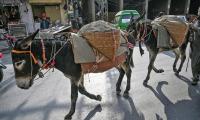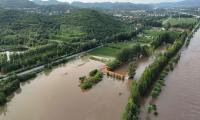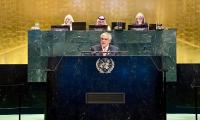ISLAMABAD: The Ministry of Finance has highlighted two major challenges confronting Pakistan’s economy, including rising inflation and external sector pressure.
"Though economic recovery is underway, the economy is also confronting inflation as well as external sector pressure. The acceleration of worldwide inflation, as well as a significant increase in freight charges is making international trade more costly,” it stated in the monthly economic report released on Monday.
It said: "Pakistan is on a high growth path. At the same time, it is confronted with persistent inflationary pressure. The level and degree of persistence of inflation is the consequence of depreciation that followed the previous balance of payments crises, reinforced by the acceleration of worldwide inflation and the exceptional surge in international commodity prices.
"These events put a lot of stress on the external accounts, more specifically on the balance in trade of goods and services and from there on the current account balance. The government aims to alleviate this stress as much as possible by implementing structural measures as well as by demand policy management. In terms of demand management, fiscal consolidation, while protecting the vulnerable sections of the population from the surge in food and energy prices, is the main objective of fiscal policy. At the same time, SBP is redirecting monetary policy from an accommodative to a more neutral stance.
"These measures should contain the current account deficit for the current FY within manageable and financiable proportion. This will also help to adjust the pressure on the exchange rate and hence on expected inflation.
"Moreover, the IMF has also acknowledged that based on available data, the government's extensive policy response to the COVID-19 pandemic had helped minimize its human and macroeconomic repercussions and thus resulting in a strong economic recovery.
"External pressures, on the other hand, have begun to materialize, mostly due to the compound impacts of increased economic activity, an expansionary macroeconomic policy mix, and rising international commodity prices. However, due to the measures taken by the government will ease out these pressures in coming months.
"Pakistan’s inflation rate is driven by the demand factors, international commodity prices, exchange rate, seasonal factors and economic agents' expectations concerning the future developments of these indicators. The year on year (YoY) inflation has marginally increased in the last two months. Going forward, this increase in inflation may be tempered by the seasonal profile whose contribution was positive in October but is usually about neutral in the months of November. Furthermore, government policy, administrative, and relief measures may support easing out the inflationary pressures. On the other hand, new impulses in November may originate due to the rise in international commodity prices."
It said: "Globally, the prices of crude oil along with all other energy inputs are on the rising trend due to increasing global demand post-COVID-19 scenarios. Added with this, a rise in freight charges has made international trade costly and caused a hike in global inflation. Even though the international price of crude oil rose by 106.7 percent on a YoY basis, however, the Government of Pakistan did not pass it on completely to the domestic consumers and adjusted duty to provide relief to the general public.
"At present, the government aims to increase agriculture productivity and provision of agri loans to ensure food security and self-sufficiency to counter food inflation. Taking into account new price impulses in November and the low base effect, it is expected that inflation may remain 8.5 to 9.5 percent. However, independent economists, including former Governor SBP Shahid Kardar, had predicted that the IMF condition would lead to reaching inflation into double-digit in Pakistan during the second half of the current fiscal year.
"According to Balance of Payment (BOP) data, the October imports of goods and services were marginally higher than their levels observed in September. In fact, in recent months these imports have roughly stabilized at relatively elevated levels.
"The continuing rise in international oil prices, exchange rate weakness and strong domestic recovery is contributing to the rising imports,” the Ministry of Finance conceded. "Given these recent dynamics and under unchanged policy assumptions, imports would remain at around current high levels during the coming months. But the recent steps taken in terms of monetary policy and other measures to curb unnecessary imports will be helpful in keeping the expansion of imports under control.
"Exports of goods and services, according to BOP data, ended just below the 3 billion USD mark in October. It is expected that in the coming months, these exports will start moving upwards again, helped by the momentum in domestic economic dynamism, specific government policies to stimulate exports and from a historical perspective, a low level of the Real Effective Exchange Rate. But these dynamics may be hindered if the economic conditions in the main export markets would take a turn for the worse, although this is not the baseline scenario.
"As a result of these events, the trade deficit in goods and services increased somewhat as compared to the level observed in September but is expected to improve in the coming months. "If remittances inflows remain at around current levels and given the expected other components of secondary income, as well as primary income balance, the expected improvement in the trade balance will be reflected in the overall current account balance. This is the baseline scenario and further ongoing developments will be monitored closely.
“Agriculture: The revised estimates for cotton production released by Cotton Crop Assessment Committee are more encouraging. The inputs availability will remain satisfactory as more certified seeds for wheat, gram and maize will be ensured for Rabi 2021-22 season.
The credit to agriculture also shows an increasing trend in FY2022, thus it is expected that in the absence of any adverse climate shock, the agriculture sector will perform better.
“Industrial activity: Industrial activity, measured by the LSM index is the sector that is most exposed to external conditions. The LSM cycle is following the cyclical movements of main trading partners, but since it is focused on the main industrial sectors and not on total GDP, it is somewhat more volatile than the cyclical components of GDP of Pakistan’s main export markets.
“Recently, the upward cyclical dynamics of Pakistan’s main export markets, measured by the CLI, were interrupted. In many countries, the COVID-19 pandemic resurged after the opening of these economies in previous months. Furthermore, economic expansion is still confronted with severe supply chain-related bottlenecks.
“For October, it is expected that LSM will resume moderate growth compared to the level observed in September, despite an expected negative seasonal effect, usually observed in the month of October and may take an upswing in the later months.”
Chairman Senate Standing Committee on Communications Senator Pervaiz Rashid presides over the committee on July 28,...
A logo is pictured outside a building of the World Health Organization . — Reuters/FileIslamabad: The World Health...
A representational image of a police tape restricting an incident scene. — Reuters/FileRawalpindi: In a significant...
A speaker addresses an event related to cardiovascular disease. — Reporter SUKKUR: Cardiovascular disease has...
A representational image of a person experiencing and reacting to chest pain. — AFP/FileSUKKUR: Cardiovascular...
An undated image of Chief Justice of Pakistan Justice Yahya Afridi. — supremecourt.gov.pk/FileChief Justice of...







